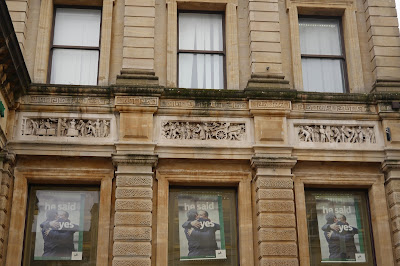The statue of Prince Albert in Queen Square
Yesterday's visit to Walsall offered us an opportunity to advance my Cities project and see Wolverhampton. Wolverhampton was named a Millennium City in 2000, along with Brighton & Hove and Inverness, having several times applied for the status. We followed the Wolverhampton City Trail, which can be downloaded from the Council website. I will try to avoid simply repeating what it says.
The trail is designed as a figure of eight and starts in Queen Square where there is an equestrian statue of Prince Albert. It was unveiled in 1866 and was Queen Victoria's first public engagement following Prince Albert's death in December 1861.
We left the Square via Exchange Street to see one of the very few timber framed buildings left in the city, now a pub. The building on the right, presumably a Victorian pub, had lovely plaster flowers on its exterior.
You emerge into a rather soulless square dominated by the rather ugly 1979 Civic Centre. Over to the right however is the city's main church, St Peter's.There has been a church in this site since 994 AD, but the present one dates mainly from the 15th century. In front of the church is a statue of Lady Wulfrun who granted land for the original church. This led to the town being renamed Wulfrun Heuntun (high place) - and this is the origin of the modern name Wolverhampton. Nothing to do with wolves!
Nearby are the buildings of Wolverhampton University (once Wolverhampton and South Staffordshire Technical College). We very much liked the glass-fronted Harrison Learning and Resource Centre.
Turning away from this brought us to Giffard House, a handsome early 18th century house built as a Mass House and priest's residence (this must have been a way of getting round the ban on building Catholic churches initiated by Elizabeth I and not repealed until 1791).
The house has been extended several times and in the 19th century a rather ugly church was built on the back, although the interior is said to be fine. This pattern of extension is even more apparent in the Molineux Hotel just off to the right. The core of this is a rich ironmaster's house of 1720, but the subsequent extensions, not least the modern one on the left, have created an awful hotchpotch. At least I can now deduce while Wolverhampton Wanderers ground, just out of shot to the right, is called Molineux.
We headed now along North Street passing the Civic Hall of 1938, by Lyons and Israel in a sort of simplified classical style.
Beyond it lies the old Town Hall, 1857, by Ernest Bates, in the Second Empire style.
Blossom's Fold (what a great street name, which apparently commemorates the wool trade) brought us to Darlington St and the massive Methodist church of 1901. This too apparently has a fine interior. We admired the cupola.
On the opposite corner is this wonderful modernist building of 1938-39 by local architect Richard Twentyman, built as a showroom and offices for the gas company. Clock Chambers still looks modern, although it is a shame that the first floor windows seem to be papered over.
School St brought is to Skinner St, where stands a seemingly unchanged Odeon cinema from the 1930s, the work of Harry Weedon. It is not exactly beautiful, but it is a remarkable survival of a style once found in many towns and cities. It is now a banqueting hall.
Victoria St brought us past the Mander Centre shopping precinct to the wonderful art deco facade of Beatties department store on the corner at the top. The stylised elephant heads were fabulous. The very helpful walk description explains that this was once a separate building belonging to Burton tailoring.
Outside Beatties was this rather lovely clock, not mentioned in our guide. It was apparently installed only in 1993.
Now back into Queen Square and past Lloyds Bank (1878) with a nice frieze depicting coal miners, farmers and metal workers.
In nearby King St we passed the attractive 19th century Old Still Inn ...
... and turned into Queen St which has a nice concentration of 19th century buildings. However, the first one of note was the 1930s Express and Star building with a wonderful relief depicting Mercury.
Further along the street is the handsome former County Court building, with the former Dispensary building visible to the left.
Passing the new bus station you come to the Chubb building, dating from as late as 1898. It is now a media centre. The brickwork seems to have been painted, which is a bit odd.
Across the railway line I noticed this rather jolly block, seemingly made out of giant Duplo bricks. It is student accommodation provided by Union State.
Finally, in Lichfield St, was the Grand Theatre, an imposing building of 1898. From here we passed the Art Gallery and the gardens by St Peter's church to return to Queen Square.
Conditions: grey and a bit misty.
Distance: a couple of miles.
Rating: Three and half stars. Our overall impression of Wolverhampton is that is a bit down-at-heel and lacking a strong overall character, but there are some very attractive buildings scattered around the city.




















1 comment:
Thanks for writing a detailed on Wolverhampton City. I really find it insightful and I must mention that you did an amazing job with pictures. One of my friend is moving to Wolverhampton University for his higher studies and actively doing research on the city so that he could easily gel up with the Culture. I will surely recommend your blog with him. Keep doing good work.
Thanks & Regards
Student Accommodation Wolverhampton
Post a Comment